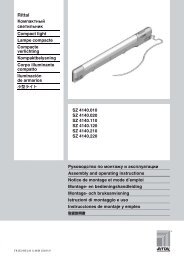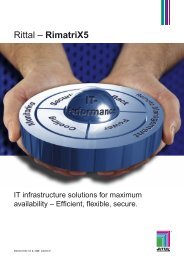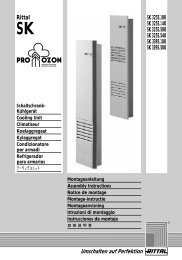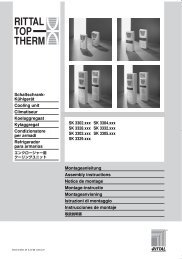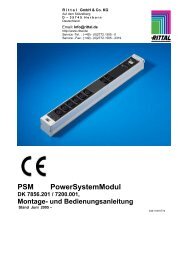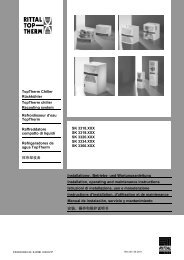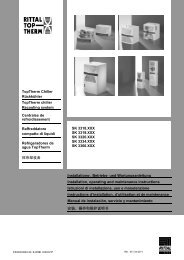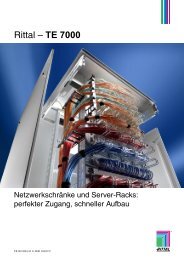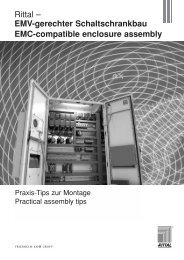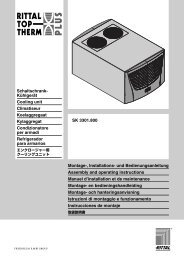Networking
Networking
Networking
Create successful ePaper yourself
Turn your PDF publications into a flip-book with our unique Google optimized e-Paper software.
Engineering and consultancy<br />
Engineering and consultancy<br />
EMC shielding<br />
Electrostatic discharges<br />
When solid materials rub against one<br />
another, electrostatic charges may arise<br />
which are rapidly discharged on conductive<br />
surfaces but which may persist for a long<br />
time on less conductive surfaces.<br />
Upon contact with conductive parts, the<br />
electrostatic voltages associated with such<br />
charges in non-conductors may cause interference<br />
or even destruction in electronic<br />
components as discharge current (conducted<br />
interference). Additionally, during<br />
Source of<br />
interference<br />
Enclosure/RF shielding<br />
High-frequency electrical currents and voltages<br />
in electronic circuits may initiate electromagnetic<br />
waves (e.g. mobile radio transmission<br />
stations, radar, as well as industrial<br />
high-frequency installations such as microwave<br />
drying, bonding and welding).<br />
These, in turn, may generate interference<br />
voltage in cables or directly in electronic<br />
assemblies via enclosure openings.<br />
Every metal enclosure already offers good<br />
basic shielding within a broad frequency<br />
range, i.e. attenuation of electromagnetic<br />
fields.<br />
High shielding attenuation levels in the frequency<br />
range above approx. 5 MHz can be<br />
achieved via special seals which conductively<br />
connect the conductive inner surfaces<br />
of doors and removable panels, roof and<br />
gland plates to the conductive sealing<br />
edges of the enclosure body or frame,<br />
largely in a slot-free manner. The higher the<br />
frequencies occurring, the more critical<br />
openings in the enclosure become.<br />
Radiation<br />
discharge, an electromagnetic pulse is<br />
irradiated, representing field-bound interference.<br />
Electrostatic discharges from humans onto<br />
control components and enclosures are particularly<br />
significant. The voltages occurring<br />
in such cases may be up to 15000 V, with<br />
discharge currents of up to 5 A, and current<br />
rise rates of up to 5 kA/µs.<br />
The risk of malfunctions or damage is increased<br />
by poorly conductive floor coverings<br />
and low air humidity.<br />
Conductance<br />
Coupling<br />
Potentially<br />
susceptible<br />
equipment<br />
Field-bound interference (low frequency)<br />
Very low-frequency currents cause a lowfrequency<br />
magnetic field which may induce<br />
interference voltage or initiate interference<br />
via direct magnetic effects (magnetic memory<br />
in computers, sensitive electromagnetic<br />
test equipment such as EEG). Low-frequency<br />
electric fields of high intensity may<br />
be generated by low-frequency high voltages<br />
(high-voltage overhead cables), resulting<br />
in interference voltage (capacitive interference).<br />
Of practical significance are magnetic<br />
fields, the effects of which can be<br />
reduced via<br />
● Shielded cables<br />
● Shielding enclosures (the decisive material<br />
property is that of permeability, which<br />
is too low in the case of sheet steel; nickel<br />
iron, for example, is much better).<br />
● Distance from the field source.<br />
Influence mechanisms and<br />
counter-measures<br />
Interference model<br />
Electrical devices which operate in an electromagnetic<br />
environment with other devices<br />
may be both transmitters and receivers of<br />
interference energy. The transmission of<br />
electrical energy from one circuit to another<br />
is known as coupling.<br />
We make a distinction between<br />
the following coupling mechanisms:<br />
● Conducted influence<br />
● Field-bound influence<br />
● Low-frequency field influence<br />
● Radiation influence<br />
Conducted interference<br />
refers to interference voltages and currents.<br />
The principal causes lie in the mechanical<br />
switching of electrical equipment (particularly<br />
inductive loads such as motors, transformers,<br />
throttling via electronic systems).<br />
Coupling of interference source and potentially<br />
susceptible equipment can occur via<br />
various “routes”. Galvanic, inductive, capacitive<br />
or wave interference are the relevant<br />
terms.<br />
Interference radiation (high-frequency)<br />
Interference can be reduced via:<br />
● Shielded cables<br />
● Shielding enclosures (Faraday cage!)<br />
Radiation of security-relevant data<br />
(TEMPEST temporary emanation and<br />
spurious transmission)<br />
The electromagnetic transmission of messages<br />
and data which must be protected<br />
from unauthorised access and the risk of<br />
accidental destruction can likewise be<br />
significantly minimised by a high shielding<br />
effect.<br />
410 Rittal IT catalogue/Engineering/Consultancy



